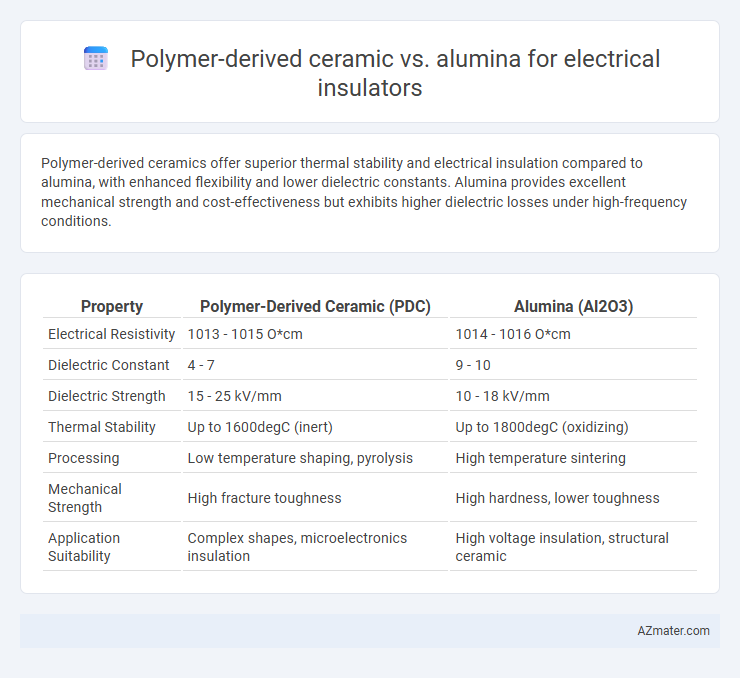Polymer-derived ceramics offer superior thermal stability and electrical insulation compared to alumina, with enhanced flexibility and lower dielectric constants. Alumina provides excellent mechanical strength and cost-effectiveness but exhibits higher dielectric losses under high-frequency conditions.
Table of Comparison
| Property | Polymer-Derived Ceramic (PDC) | Alumina (Al2O3) |
|---|---|---|
| Electrical Resistivity | 1013 - 1015 O*cm | 1014 - 1016 O*cm |
| Dielectric Constant | 4 - 7 | 9 - 10 |
| Dielectric Strength | 15 - 25 kV/mm | 10 - 18 kV/mm |
| Thermal Stability | Up to 1600degC (inert) | Up to 1800degC (oxidizing) |
| Processing | Low temperature shaping, pyrolysis | High temperature sintering |
| Mechanical Strength | High fracture toughness | High hardness, lower toughness |
| Application Suitability | Complex shapes, microelectronics insulation | High voltage insulation, structural ceramic |
Introduction to Electrical Insulators
Polymer-derived ceramics (PDCs) offer superior thermal stability and dielectric strength compared to traditional alumina, making them highly effective as electrical insulators in harsh environments. Alumina, a widely used ceramic insulator, provides excellent mechanical strength and chemical inertness but may degrade under extreme thermal cycling. The unique molecular structure of PDCs enables enhanced electrical insulation performance, particularly in high-temperature and corrosion-prone applications.
Overview of Polymer-Derived Ceramics
Polymer-derived ceramics (PDCs) are advanced materials synthesized through the pyrolysis of preceramic polymers, offering exceptional electrical insulation properties and thermal stability superior to conventional alumina. Unlike alumina, PDCs exhibit enhanced miniaturization potential due to their nanostructured amorphous matrix, resulting in lower dielectric constants and improved resistance to high-frequency electrical breakdown. These characteristics make PDCs ideal for next-generation electrical insulators in harsh environments where alumina's crystalline structure may undergo degradation.
Alumina as an Electrical Insulator
Alumina (Al2O3) is a widely used electrical insulator distinguished by its high dielectric strength, thermal stability, and excellent electrical resistivity, making it ideal for high-voltage applications. In contrast, polymer-derived ceramics offer tailored compositions but generally exhibit lower electrical insulation performance compared to alumina's superior breakdown voltage and consistent insulating properties. The robustness and reliability of alumina ceramic insulators drive their prevalence in industrial electrical components, such as insulator tubes and substrates in power electronics.
Dielectric Properties Comparison
Polymer-derived ceramics exhibit superior dielectric properties compared to alumina, including higher dielectric strength and lower dielectric constant, which enhance their efficiency as electrical insulators. The intrinsic microstructure of polymer-derived ceramics allows for better control of electrical insulation performance, with dielectric losses significantly reduced under high-frequency conditions. In contrast, alumina, while possessing good thermal stability and mechanical strength, typically shows higher dielectric constant and increased dielectric loss, limiting its application in advanced high-frequency insulator designs.
Mechanical Strength and Durability
Polymer-derived ceramics exhibit superior mechanical strength compared to alumina, with enhanced fracture toughness and flexibility that reduce brittleness in electrical insulators. These ceramics also offer greater durability under thermal cycling and harsh environmental conditions, maintaining structural integrity and insulating properties over extended periods. In contrast, alumina insulators demonstrate excellent hardness but are more prone to microcracking and mechanical failure under mechanical stress and thermal expansion mismatch.
Thermal Stability and Resistance
Polymer-derived ceramics (PDCs) exhibit superior thermal stability compared to alumina, maintaining insulation properties at temperatures exceeding 1500degC, while alumina typically operates effectively up to around 1200degC. PDCs offer enhanced resistance to thermal shock and chemical degradation, making them ideal for high-performance electrical insulator applications in extreme environments. Alumina remains popular due to its excellent dielectric strength and cost-effectiveness but is limited by lower tolerance to rapid temperature fluctuations and oxidative conditions.
Manufacturing and Processing Differences
Polymer-derived ceramics (PDCs) offer superior manufacturing flexibility compared to alumina, allowing for complex shapes through polymer shaping and pyrolysis processes, whereas alumina requires high-temperature sintering and rigid powder compaction techniques. PDCs undergo low-temperature polymer-to-ceramic transformation, enabling finer microstructural control and reducing processing steps, while alumina's sintering demands temperatures above 1600degC with longer cycle times to achieve densification. The customizable chemistry of PDC precursors allows tailored electrical insulation properties, contrasting with alumina's fixed crystalline structure and limited compositional variation.
Cost Effectiveness and Scalability
Polymer-derived ceramics (PDCs) offer cost-effective manufacturing due to lower processing temperatures and simpler fabrication methods compared to traditional alumina, reducing overall energy consumption and production expenses. Their scalability is enhanced by the versatility of polymer precursors, allowing for easy shaping and mass production without the need for sintering at extremely high temperatures required by alumina ceramics. Despite alumina's well-established performance as an electrical insulator, PDCs present a competitive alternative by combining cost-efficiency with scalable manufacturing suitable for large-scale industrial applications.
Environmental Impact and Sustainability
Polymer-derived ceramics (PDCs) offer superior sustainability compared to alumina due to lower energy consumption during synthesis and the ability to utilize abundant, renewable polymer precursors. Alumina production involves high-temperature processes with significant CO2 emissions and mining impacts, whereas PDCs generate fewer greenhouse gases and reduce reliance on rare raw materials. Life cycle assessments highlight PDCs' reduced environmental footprint, making them a more eco-friendly choice for electrical insulator applications.
Application Suitability and Industry Trends
Polymer-derived ceramics (PDCs) offer superior thermal stability and customizable microstructures, making them highly suitable for high-temperature electrical insulator applications in aerospace and power electronics. Alumina remains the industry standard due to its excellent dielectric strength, mechanical robustness, and cost-effectiveness in traditional insulation systems like transformers and capacitors. Emerging trends emphasize hybrid materials combining PDCs and alumina to enhance performance in harsh environments, driven by demand in electric vehicles and advanced microelectronics.

Infographic: Polymer-derived ceramic vs Alumina for Electrical insulator
 azmater.com
azmater.com